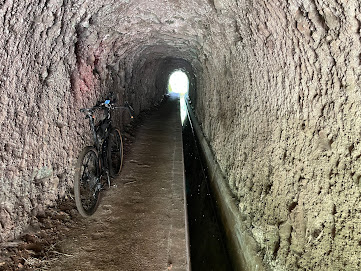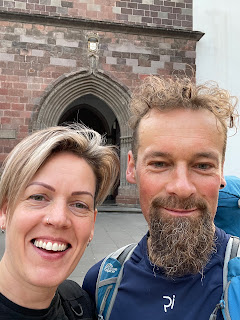Ask anyone who’s ridden a bike on the island of Madeira and one of a couple of words will usually figure in their reply; ‘hilly’ or ‘lumpy’ are a polite understatement for what you’ll encounter on an island where many of the urban roads have gradients of 20% or more. Cars have to park with their wheels turned to full lock in case the handbrake fails; pavements are flights of stairs.
The lack of information about riding on Madeira should have been a warning to me. Sure, you can hire a MTB and surf the uplift but aside from that it is not a popular road or gravel biking destination despite having stunning views, varied scenery and great roads. Two weeks prior to departure a quick scan of some Madeiran maps and Google Earth showed dramatic views and proper mountains; all on an island that is only 740km2. The island is made up of a former shield volcano which rises 6km from the floor of the Atlantic ocean. A sub-tropical climate combined with fertile volcanic soil is the reason for the lush appearance of the island. Most inhabitants live close to the coast, many in houses that cling to the side of steep foothills. Main roads tunnel though mountains and leap deep gorges to circumnavigate the island.
It was with a mixture of excitement and trepidation that I rolled my bike out of the front door of my Funchal hotel in March 2022, this was going to be different!
Day 1
A short spin to suss out the terrain, less than 30 miles up to the second highest point on the island. The road out of Funchal (island capital) kicked straight up from sea level at a gradient of 25% for an improbable stretch. It continued at an incline of 1 in 5 to 1850ft by which point I’d exchanged the fumes and noise of the city for swishing bamboo and eucalyptus groves. I checked my average speed, 5.7mph. At this rate a 30 mile ride was going to take 4 hours. The gradient relented a little above 2000ft, skinny eucalyptuses towered over moss clad stone walls and the blue blooms of ‘pride of Madeira’ bushes flanked the roadside. The tarmac snook along the side of the mountain at a more reasonable 10% gradient, the hectic roads of the city still in view 2000 feet below; matchbox cars and toy ships at my feet.
High above the Funchal suburb of Monte a pair of Dutch tourists told me about their bikes back home, they were glad to be driving a hire car here though. They weren’t the last visitors I met who had considered bringing or hiring a bike but changed their mind on seeing the terrain.
It was a long way down to the sea from here, but further still to my destination peak. I got back on the bike and pointed my front wheel upwards, up and up until the eucalyptus gave way to pine trees and more civilised alpine switchbacks. The ‘clang’ of cowbells and smell of sheep dung was a sure sign that I was in the mountains. I spied an oversize golf ball balanced on the peak of Areiro at 5964 feet up. Crawling with tourists stealing unearned summit selfies I made an about turn and returned seaward. Gravel tyres squirming all the way back to Funchal.
Day 2
Day two's riding required a change of strategy. A route out to the north eastern tip and Santana would be less vertical and cover a little more ground. Skirting the coast and expressway via the suburbs of Caniço and Santa Cruz I was soon rolling into Machico. Continuing north east a steep climb dumped me in a dark tunnel before an exhilarating winding descent to the sharpening peninsula that made up the north eastern point or Madeira. Tall, crumbling cliffs fell away from the end-of-the-road car park.
Looking west from this, the eastern most point on the island the northern coast appeared impenetrable. Near vertical slopes stretched from sky to ocean leaving no room for road or path. Somewhere along that coast was my next stop; the village of Santana.
I retraced my route towards Machico before taking a right turn to pick up a levada trail. The levadas were built centuries ago to collect the mountain rainfall for agriculture. These mini-canals were built from stone or concrete, follwing the mountain contours to deliver water to where it was most needed. The also make great gravel riding, little used single track trails following the contours of the mountain make great good gravel going and I rode this particular levada-side path until it dived under an expressway. There was little option but to take the expressway tunnel through the centre of the island to Santana where after a 1000 foot plus climb I arrived in the village of Santana. It wasn’t quite the tourist attraction I’d expected but there were plenty of selfie stick toting tourists nonetheless. Hire cars of visitors flocked to Santana to see the traditional red and white tent shaped houses that were a common sight on the island in centuries gone by . Triangular in profile they were built from wood and straw with only two basic rooms. The thatched straw roof shrugged off rain and kept the temperature up even during the colder times of the year.
 My return to Funchal was over the centre of the island, a long climb from sea level at Faial to the alpine Pension at Poiso. The northern slopes of the island were crammed with dense vegetation; stone walls clad in a lush carpet of moss and ferns. Overhead hung creepers, dangling limp from overhanging laurel. I climbed by road through stone hamlets clinging to a narrow ridge that led to the centre of the island. Grey cottages of stone and slate lined the road south, their monochrome palette livened up by tangles of tumbling orange nursturtiums. The constant burbling of roadside rainwater drains soundtracked my climb.
My return to Funchal was over the centre of the island, a long climb from sea level at Faial to the alpine Pension at Poiso. The northern slopes of the island were crammed with dense vegetation; stone walls clad in a lush carpet of moss and ferns. Overhead hung creepers, dangling limp from overhanging laurel. I climbed by road through stone hamlets clinging to a narrow ridge that led to the centre of the island. Grey cottages of stone and slate lined the road south, their monochrome palette livened up by tangles of tumbling orange nursturtiums. The constant burbling of roadside rainwater drains soundtracked my climb. As on the previous day pine needles eventually took the place of eucalyptus leaves, broom supplanted Pride of Madeira. I didn’t need to check the altimeter on my watch, I could tell I was nearing the summit before the familiar plummet back to Funchal.
Day 3
I was eager to discover more gravel riding and I’d spotted a route by Ed Shoote which I wanted to try.
My version would take me south west to Ribeira Brava before diverting north through the centre of the island to Sao Vicente where I would pick up a long gravel climb to a plateau at 3000 feet.
Having left Funchal I was soon climbing up and over one of the highest sea cliffs in Europe. A right turn onto a 25% climb up a concrete driveway had me double checking Komoot’s suggested route. 1-0 to Komoot, I just needed to suck it up and climb.
Having eventually made it over the summit the road opened out and I enjoyed a fast descent to Ribeira Brava. A right turn led along a steep sided valley with mountains towering to my right and stacks of terraced strips to my left. The terrain tightened leaving the road with no option but to tunnel through the mountain ahead of me.
I emerged on the north side of the island but it wasn’t long before I picked up a residential road snaking up through small vineyards and streets of white bungalows.
Above Sao Vicente the road became a track, gravel and stone carpeted in crisp fallen eucalyptus leaves. I should have counted the number of hairpins to the top of the track, loads, but there was no need - the volume of the distant ‘whoosh’ of wind turbine blades far above was my gauge of progress. A brief glance upwards revealed a near vertical slope and I couldn’t quite work out how I’d get up there.
Lizards darted to safety at every turn of my wheels, a constantly shifting rustling sound, just the occasional flash of a green scaly tail. With every completed hairpin there was a subtle change in the trees and shrubs lining the track. Over a few hundred vertical metres sub-tropical eucalyptus were replaced by laurel, palm gave way to the yellow blooms of broom and gorse.
The track became rough, boulders bullied gravel aside and picking a line required all my attention and strength. Looking up I realised I was climbing into the cloud; damp air and a cool breeze greeting me as the terrain levelled. Rolling away from the edge of the escarpment the cloud lifted a little to reveal flat gorse moorland stretching away to meet distant low cloud.
I refilled my water at a communal camp site a mile later before picking up the closed road that would return me to sea level. I lifted my bike over a chunky steel barrier with a large no entry sign and rolled down the descent dodging the boulders that littered the road. I was now back in the cloud with no idea of whether the road was passable. The first tunnel on the descent was pitch black, the road pock marked by fallen rock. The second tunnel had a crew of men with pick axes repairing the road near the exit, they didn’t seem too pleased to see me coming though…
Mangled roadside crash barriers reminded me of the ‘Death Road’ on the Torino-Nice Rally route, another road closed by rockfall and persistent tragedy. Fortunately I'd escaped unscathed, I hopped another steel barrier to return to Funchal dodging tourist coaches and Piaggio Apes.
Madeira as a cycling destination requires a recalibration, you can easily climb 2000ft for every 10 miles you ride, even on the road. The levadas make excellent gravel riding but the popular ones around tourist hotspots are probably best avoided unless you enjoy stopping every thirty seconds whilst packs of pensioners re-orientate themselves. Elsewhere they are an excellent way to see the island without committing to 1000’s of feet of climbing every ride. There are also miles of old paths like the Royal Paths which survive outside urban areas. These are often built from flint and cobbles and are mainly mud free. Views and descents are hard won on Madeira and all the better for it. The island is certainly worth considering as an off season destination, it never gets uncomfortably hot or cold and it'll make you see your usual hills back home in a new light.














































































































